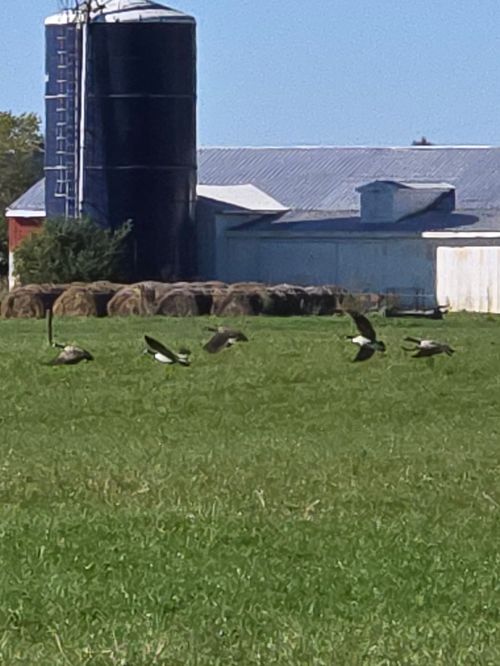Fall brings bird flu risks: What poultry owners need to know
With highly pathogenic avian influenza (HPAI) still spreading across the U.S., poultry keepers must stay alert this fall to safeguard both backyard and commercial flocks.

As fall arrives, the beautiful colors of autumn also bring new risks for poultry producers and backyard bird owners. As wild birds complete their seasonal migration, there is an increased risk of avian influenza (bird flu), especially highly pathogenic avian influenza (HPAI).
Since the outbreak of HPAI began in February 2022, a majority of cases have been linked to migratory wild birds. Waterfowl, such as ducks and geese, are natural carriers of the virus. These birds often show no signs of illness but can pass the virus to domestic poultry through shared water sources, contaminated feed, clothing or equipment.
In large commercial operations, where thousands of birds are housed closely together, the spread of bird flu can be rapid and devastating. Once detected in one of these operations, the entire flock must be humanely euthanized to contain the virus and protect other farms from potential infection. Your vigilance and quick action in reporting suspected cases can help contain the virus and protect other farms from potential infection.
Scope of the outbreak since 2022
According to surveillance data from the United States Department of Agriculture-Animal Plant Health Inspection Service (USDA-APIHS), since 2022, there have been more than 1,700 reported HPAI outbreaks in 685 counties, including all 50 states and Puerto Rico, affecting both commercial farms and backyard flocks. As of the latest data:
- In 2025, Michigan confirmed three outbreaks in commercial poultry flocks and eight in backyard flocks.
- In 2024, the state experienced its most extensive outbreak on record, with 31 dairy herds and 11 commercial poultry flocks impacted.
Risk to humans
Avian influenza is a zoonotic disease, meaning it can be passed between and infect both animals and people. However, the risk to the general public remains very low. According to the Centers for Disease Control and Prevention (CDC), 70 human cases have been reported in the U.S. to date, and the majority of those have been associated with direct exposure to infected animals on farms. This includes:
- 41 individuals linked to infected dairy cattle.
- 24 cases related to poultry farms or culling operations.
Symptoms of HPAI in humans can range from mild, flu-like illnesses to severe respiratory disease and, in rare cases, death. In the U.S., most reported human cases involved mild symptoms, particularly eye redness or conjunctivitis.
Importantly, properly cooked poultry, eggs and pasteurized milk are safe to consume, as the virus does not spread through cooked or pasteurized dairy products.
Protecting your birds through biosecurity
As fall migration peaks, poultry owners must take charge and strengthen their biosecurity practices. By doing so, you are actively protecting your flock from potential bird flu risks.
- Prevent or limit contact between wild birds and domestic birds:
- Remove standing water.
- Fence off natural ponds and vegetative areas around barns and pasture or free-ranging areas.
- Reduce food sources for wild birds.
- Cover animal carcasses.
- Plug holes where wild birds can enter and exit coops.
- Wear clean clothing and footwear while caring for animals.
- Practice good personal hygiene by frequently washing hands with soap and water.
- Regularly clean and disinfect tools and equipment used on the farm.
- Limit farm visitors: if service professionals must come on the farm, identify a specific area for parking away from animal housing and provide visitors with disposable foot coverings.
- Do not visit neighboring flocks. If you must, wear different clothing and footwear than you wear with your flock.
- Limit exposure to your flock from anyone who has had contact with other flocks of birds or infected cattle.
- Keep a visitor log that includes the date individuals visited your flock and their contact information.
- Separate, or ideally isolate, any newly acquired animals for a minimum of 14 days and monitor new animals for signs of illness.
- Know the signs and symptoms of illness.
- Care for new, separated, isolated or sick animals last.
- Limit visitor access to your flock, especially during high-risk migration seasons.
Symptoms of HPAI
According to the American Veterinary Medical Association, birds infected with HPAI may exhibit one or more of the following symptoms:
- Sudden death with no prior signs.
- Lack of coordination.
- Low energy or appetite.
- Purple discoloration or swelling of head, comb, wattles, eyelids and/or hocks.
- Reduced egg production or soft-shelled, misshapen eggs.
- Nasal discharge, coughing or sneezing.
Free biosecurity assessment
If you own a farm with 25 or more birds, you may qualify for a free on-farm biosecurity assessment. Participants receive recommendations to improve their farm’s disease prevention practices, along with compensation for their time. All participant information is kept confidential.
To learn more, contact czerni10@msu.edu or 517-432-5402
Reporting possible cases of HPAI
For domestic poultry
The Michigan Department of Agriculture and Rural Development (MDARD) notes that HPAI is not evidenced by one bird showing symptoms or dying while the remaining flock continues acting normally. Small flock and backyard poultry owners should take notice when two or more birds die within a 24-hour period and the rest of the flock is exhibiting symptoms of HPAI. If you suspect bird flu, call MDARD (Michigan Department of Agriculture and Rural Development):
- 800-292-3939 (regular hours)
- 517-373-0440 (after hours)
For wildlife
If unusual deaths in wild birds or other wildlife are noticed, cases should be reported to the Michigan Department of Natural Resources by using the Eyes in the Field app (select "Diseased Wildlife") or by calling the Wildlife Disease Laboratory at 517-336-5030.



 Print
Print Email
Email